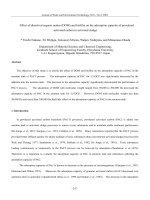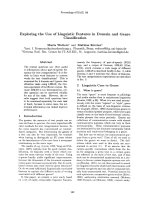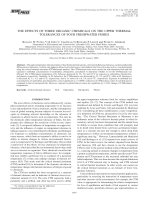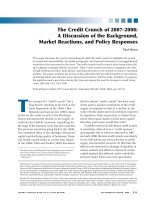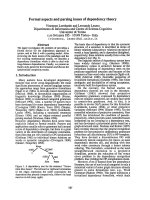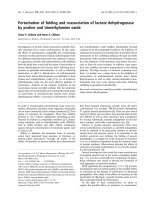Re-Evaluation of Some Organic Chemicals, Hydrazine and Hydrogen Peroxide potx
Bạn đang xem bản rút gọn của tài liệu. Xem và tải ngay bản đầy đủ của tài liệu tại đây (380.64 KB, 171 trang )
WORLD HEALTH ORGANIZATION
INTERNATIONAL AGENCY FOR RESEARCH ON CANCER
IARC Monographs on the Evaluation of Carcinogenic Risks to Humans
Volume 71
Re-Evaluation of Some Organic Chemicals,
Hydrazine and Hydrogen Peroxide
Summary of Data Reported and Evaluation
Part One - Compounds reviewed in plenary sessions (comprehensive monographs)
Acrylonitrile
1,3-Butadiene
Chloroprene
Dichloromethane
Part Two - Other compounds reviewed in plenary sessions
Acetaldehyde
Aziridine
Benzoyl peroxide
n-Butyl acrylate
γ-Butyrolactone
Caprolactam
Carbon tetrachloride
Catechol
α-Chlorinated toluenes and benzoyl chloride
1,2-Dibromo-3-chloropropane
1,2-Dichloroethane
Dimethylcarbamoyl chloride
Dimethylformamide
Dimethyl sulfate
1,4-Dioxane
Epichlorohydrin
1,2-Epoxybutane
Ethylene dibromide (1,2-dibromoethane)
Hydrogen peroxide
Hydroquinone
Methyl bromide
Methyl chloride
Phenol
Polychlorophenols and their sodium salts
1,1,2,2-Tetrachloroethane
Toluene
Toluene diisocyanates
1,1,1-Trichloroethane
Tris(2,3-dibromopropyl) phosphate
Vinyl bromide
Part Three - Compounds not reviewed in plenary sessions
Part Three A - Extensive new data requiring new summaries
1,3-Dichloropropene
1,2-Dimethylhydrazine
Hydrazine
Isoprene
Isopropanol
Malonaldehyde (malondialdehyde)
4,4
′-Methylenediphenyl diisocyanate and polymeric 4,4′-methylenediphenyl diisocyanate
Methyl methanesulfonate
2-Nitropropane
1,3-Propane sultone
β-Propiolactone
Resorcinol
1,1,1,2-Tetrachloroethane
Tetrafluoroethylene
1,1,2-Trichloroethane
Vinylidene chloride
N-Vinyl-2-pyrrolidone and polyvinylpyrrolidone
Xylenes
Part Three B - Few new data
Acetamide
Acrylic acid
Allyl chloride
Allyl isovalerate
1,4-Benzoquinone (para-quinone)
1,4-Benzoquinone dioxime
Benzyl acetate
Bis(2-chloroethyl)ether
1,2-Bis(chloromethoxy)ethane
1,4-Bis(chloromethoxymethyl)benzene
Bis(2-chloro-1-methylethyl)ether
Bis(2,3-epoxycyclopentyl)ether
Bisphenol A diglycidyl ether
Bromochloroacetonitrile
Bromodichloromethane
Bromoethane
Bromoform
β-Butyrolactone
Carbazole
Chloroacetonitrile
Chlorodibromomethane
Chlorodifluoromethane
Chloroethane
Chlorofluoromethane
2-Chloro-1,1,1-trifluoroethane
Cyclohexanone
Decabromodiphenyl oxide
Dibromoacetonitrile
Dichloroacetonitrile
Dichloroacetylene
trans-1,4-Dichlorobutene
1,2-Dichloropropane
1,2-Diethylhydrazine
Diethyl sulfate
Diglycidyl resorcinol ether
Diisopropyl sulfate
1,1-Dimethylhydrazine
Dimethyl hydrogen phosphite
3,4-Epoxy-6-methylcyclohexylmethyl 3,4-epoxy-6-methylcyclohexane carboxylate
cis-9,10-Epoxystearic acid
Ethyl acrylate
Glycidaldehyde
Hexamethylphosphoramide
Isopropyl oils
Lauroyl peroxide
Methyl acrylate
2-Methylaziridine (propyleneimine)
Methyl iodide
Morpholine
1,5-Naphthalene diisocyanate
Pentachloroethane
Phenyl glycidyl ether
Tetrakis(hydroxymethyl)phosphonium salts
Trichloroacetonitrile
Triethylene glycol diglycidyl ether
Tris(2-chloroethyl) phosphate
1,2,3-Tris(chloromethoxy)propane
Vinylidene fluoride
Last updated: 8 April 1999
ACRYLONITRILE
(Group 2B)
For definition of Groups, see Preamble Evaluation.
VOL.: 71 (1999) (p. 43)
CAS No.: 107-13-1
Chem. Abstr. Name: 2-Propenenitrile
5. Summary of Data Reported and Evaluation
5.1 Exposure data
Acrylonitrile is a monomer used in high volume principally in the manufacture of acrylic fibres, resins
(acrylonitrile–butadiene–styrene, styrene–acrylonitrile and others) and nitrile rubbers (butadiene–acrylonitrile).
Other important uses are as an intermediate in the preparation of adiponitrile (for nylon 6/6) and acrylamide
and, in the past, as a fumigant. Occupational exposures to acrylonitrile occur in its production and use in the
preparation of fibres, resins and other products. It is present in cigarette smoke and has been detected rarely
and at low levels in ambient air and water.
5.2 Human carcinogenicity data
The potential carcinogenicity of acrylonitrile in occupationally exposed populations has been investigated in
several epidemiological studies. Studies carried out in the 1970s and 1980s suggested a possible increased
risk of lung cancer among workers exposed to acrylonitrile. However, these were inconclusive because of one
or more of the following actual or potential problems: small sample sizes, insufficient length of follow-up,
incompleteness of follow-up, inadequate exposure assessment, potential confounding by other occupational
carcinogens, and potential confounding by smoking. Consequently, larger and better studies were undertaken,
in most cases building upon the same cohorts that had previously been assembled. Four such studies (two in
the United States, one in the United Kingdom and one in the Netherlands) were carried out and these now
provide the most relevant, informative data on which to base an evaluation. All of the studies made some
attempt to establish exposure levels, although for the British study, this was rather cruder than for the others.
The two studies from the United States were carried out in similar industries, but the range of cumulative
exposure values was quite different between the two, raising questions about the inter-study comparability of
methods of exposure assessment. The four studies employed different strategies for comparing exposed with
unexposed. While the British study used a classic SMR comparison with national rates, the Dutch study did the
same, but also compared the exposed with a different unexposed cohort. One of the studies from the United
States compared the exposed with national rates and with rates of mortality and incidence in other plants of
the same large company. The other compared the exposed with workers in the same plants who were
unexposed to acrylonitrile. Typically, in each study, a number of analyses were carried out, varying
comparison groups and other parameters.
There was no significant excess risk for any type of cancer when all exposed workers were compared with
unexposed, or with an external comparison population. Further, when the study subjects were subdivided by
levels of exposure (cumulative exposure when feasible), for no site but lung was there any hint that risk
increased with exposure. For lung cancer, there was an indication that workers with the highest exposures had
relative risk estimates greater than 1.0. This finding was strongest in the largest of the studies, which had one
of the most intensive exposure assessment protocols, but the other studies gave either negative or only
weakly supportive results. Even in the largest study (where the relative risk in the highest exposure quintile
ranged from 1.2 to 1.7 depending on the parameters in the analysis), the finding was not consistently
statistically significant; there was no coherent dose–response pattern throughout the range of exposures and
the risk in the highest decile of exposure was lower than that in the second highest decile. On balance and
given the largely unsupportive findings from the other studies, the evidence from this one study was not
considered to be sufficiently strong to conclude that there was a credible association between acrylonitrile and
lung cancer. Thus, the earlier indications of an increased risk among workers exposed to acrylonitrile were not
confirmed by the recent, more informative studies.
5.3 Animal carcinogenicity data
Acrylonitrile has been tested for carcinogenicity in one study in rats by inhalation with pre- and postnatal
exposure. This study confirmed the findings of increased incidences of glial cell tumours of the central nervous
system found in several previous studies that had not been fully reported and also found increases in
malignant mammary tumours, Zymbal gland carcinomas, benign and malignant hepatocellular tumours and
extrahepatic angiosarcomas.
5.4 Other relevant data
Acrylonitrile forms adducts with proteins and glutathione. It also forms DNA adducts in vitro, but only after
cytochrome P450 bioactivation, most likely through its epoxide metabolite (cyanoethylene oxide), which is also
formed in vivo. Acrylonitrile–haemoglobin adducts have been detected in exposed workers.
Both acrylonitrile and cyanoethylene oxide can conjugate with glutathione, leading to detoxification of these
reactive compounds. At high doses of acrylonitrile, as used in animal studies, glutathione in certain tissues
may be depleted. Such glutathione depletion will probably not occur at low-level human exposure.
Acrylonitrile is mutagenic in vitro; in Salmonella systems, bioactivation (to cyanoethylene oxide) is required, but
in Escherichia coli and in rodent systems, bioactivation by an added microsomal system is not required. The
results of genotoxicity experiments in vivo have in most cases been negative, although acrylonitrile is
mutagenic in Drosophila.
5.5 Evaluation
There is inadequate evidence in humans for the carcinogenicity of acrylonitrile.
There is sufficient evidence in experimental animals for the carcinogenicity of acrylonitrile.
Overall evaluation
Acrylonitrile is possibly carcinogenic to humans (Group 2B).
For definition of the italicized terms, see Preamble Evaluation.
Previous evaluations: Vol. 19 (1979) (Acrylonitrile and copolymers); Suppl. 7 (1987)
Synonyms
● AN
● Cyanoethylene
● Propenenitrile
● VCN
● Vinyl cyanide
Last updated: 12 April 1999
1,3-BUTADIENE
(Group 2A)
For definition of Groups, see Preamble Evaluation.
VOL.: 71 (1999) (p. 109)
Butadiene
CAS No.: 106-99-0
Chem. Abstr. Name: 1,3-Butadiene
Diepoxybutane
CAS No.: 1464-53-5
Chem. Abstr. Name: 2,2′-Bioxirane
5. Summary of Data Reported and Evaluation
5.1 Exposure data
1,3-Butadiene is a monomer used in high volume in the manufacture of a wide range of polymers, including
styrene–butadiene rubber, polybutadiene, nitrile rubber, acrylonitrile–butadiene–styrene resins and
styrene–butadiene latexes. It is also an intermediate in the production of various other chemicals.
Occupational exposure to 1,3-butadiene occurs in the production of monomeric 1,3-butadiene and of 1,3-
butadiene-based polymers and 1,3-butadiene-derived products. The mean full-shift, time-weighted average
exposure levels measured for workers in these industries have usually been below 10 ppm [22 mg/m
3
],
although that level may be exceeded during some short-term activities. Recent data from monomer extraction
and styrene–butadiene rubber plants showed lower average concentrations (< 5 ppm [< 11 mg/m
3
]. 1,3-
Butadiene is not usually found at detectable levels in workplace air during manufacture of finished rubber and
plastic products.
The general population may be exposed to very low levels of 1,3-butadiene due to its occurrence in engine
exhausts and cigarette smoke.
5.2 Human carcinogenicity data
One cohort study of workers in the United States who manufactured 1,3-butadiene monomer showed a
moderate and significant excess of lymphohaematopoietic cancers based on 42 deaths. Persons employed
before 1950 were especially at increased risk, but there was no convincing association with a cumulative
exposure score. A total of 13 leukaemia cases only slightly and insignificantly contributed to the excess of the
lymphohaematopoietic cancers.
A small cohort study of 1,3-butadiene production workers showed a significant excess of lymphosarcoma and
reticulosarcoma, based on four cases. There was also an excess of stomach cancer, although represented by
only five cases. Two leukaemia cases were found: this was slightly more than expected.
Several reports have been published on follow-up of styrene–butadiene rubber workers at eight plants in the
United States and Canada. The most recent follow-up showed a consistent excess of leukaemia and a
significant dose–response relationship with cumulative exposure to 1,3-butadiene, which remained after
adjustment for exposure to styrene.
Evaluation of the human carcinogenicity of 1,3-butadiene hinges on evidence regarding leukaemia risks from
one large and well conducted study and two smaller studies. The smaller studies neither support nor contradict
the evidence from the larger study. The larger, United States–Canada study shows that workers in the
styrene–butadiene rubber industry experienced an excess of leukaemia and that those with apparently high
1,3-butadiene exposure had higher risk than those with lower exposure. The evidence from this study strongly
suggests a hazard, but the body of evidence does not provide an opportunity to assess the consistency of
results among two or more studies of adequate statistical power. Further, while 1,3-butadiene was a major
exposure in this cohort, there were others, and it remains possible that even if there is an increased risk of
cancer in the styrene–butadiene rubber industry, it may be due to occupational exposures other than 1,3-
butadiene.
5.3 Animal carcinogenicity data
1,3-Butadiene was tested for carcinogenicity by inhalation exposure in four experiments in mice and one
experiment in rats.
In the studies in mice, tumours were induced in multiple organs at all exposure concentrations studied, ranging
from 6.25 to 1250 ppm [13.8–2760 mg/m
3
]. The tumours induced included malignant lymphomas and heart
haemangiosarcomas. Neoplasms at multiple organ sites were induced in mice after as little as 13 weeks of
exposure at exposure levels of 625 ppm.
In one inhalation study in rats, 1,3-butadiene increased the incidence of tumours at several sites. The tumour
increases were mainly in organs in which tumours develop spontaneously. The response was seen mainly at
8000 ppm [17 700 mg/m
3
].
The initial metabolite of 1,3-butadiene, 1,2-epoxy-3-butene, yielded equivocal results in carcinogenicity tests,
whereas the subsequent metabolite, 1,2:3,4-diepoxybutane, was carcinogenic to mice and rats when
administered by skin application or by subcutaneous injection.
5.4 Other relevant data
1,3-Butadiene is metabolized in experimental animals and human liver microsomes to epoxide metabolites,
initially 1,2-epoxy-3-butene and subsequently 1,2:3,4-diepoxybutane, by cytochrome P450. The epoxides can
be inactivated by epoxide hydrolase and glutathione S-transferases. Adducts formed by reaction of 1,2-epoxy-
3-butene and 3,4-epoxy-1,2-butanediol with haemoglobin and urinary mercapturic acids derived from 1,2-
epoxy-3-butene have been detected in 1,3-butadiene-exposed workers. There are significant species
differences in the metabolism of 1,3-butadiene both in vitro and in vivo. The in-vitro data are consistent with
modelled and measured concentrations of 1,2-epoxy-3-butene and 1,2:3,4-diepoxybutane in 1,3-butadiene-
exposed mice and rats. In these animals, blood and tissue levels of 1,2-epoxy-3-butene are several times
higher in mice than in rats and those of 1,2:3,4-diepoxybutane up to 100 times higher in mice than in rats.
There is considerable interindividual variability in the ability of human liver microsomes to metabolize 1,3-
butadiene and 1,2-epoxy-3-butene in vitro. Mechanistic data suggest that the much higher carcinogenic
potency of 1,3-butadiene in mice than in rats results predominantly from the high burden of 1,2:3,4-
diepoxybutane.
The haemoglobin-binding index of 1,2-epoxy-3-butene can be considered as a dose surrogate for this
metabolite; corresponding haemoglobin-binding indices have been published for mouse and rat. Haemoglobin-
binding indices in occupationally exposed humans have also been estimated. In agreement with model
predictions, these data demonstrate binding indices for 1,3-butadiene-exposed humans more than one order
of magnitude lower than those in exposed rats.
There are conflicting results on whether 1,3-butadiene increases hprt mutations in lymphocytes from 1,3-
butadiene-exposed humans compared with non-exposed controls. Sister chromatid exchanges, micronuclei,
chromosomal aberrations and DNA strand breaks were not significantly elevated above control levels in
peripheral blood lymphocytes of occupationally exposed workers. 1,3-Butadiene induced DNA adducts and
damage in both mice and rats in vivo, although the damage was significantly greater in mice than in rats. 1,3-
Butadiene is mutagenic in virtually all test systems both in vitro and in vivo. Where a direct comparison
between rats and mice could be made for the same end-point, positive effects were observed primarily in mice.
Activated K-ras oncogenes have been detected in lymphomas and in liver and lung tumours induced in mice
by 1,3-butadiene. Mutations in the p53 tumour-suppressor gene have been detected in mouse lymphomas.
1,2-Epoxy-3-butene was directly mutagenic in bacteria and induced gene mutations, chromosomal aberrations
and sister chromatid exchanges in vivo in rodents. Micronuclei were induced in both somatic and germ cells of
mice and rats in vivo. It induced gene mutations and sister chromatid exchanges in cultured human
lymphocytes but did not induce unscheduled DNA synthesis, micronuclei or chromosomal aberrations in
mouse or rat cells in vitro.
1,2:3,4-Diepoxybutane is a potent bifunctional alkylating agent which reacts with DNA in vitro and in vivo. As a
result, it is mutagenic in virtually all test systems including effects in somatic and germ cells of mammals
exposed in vivo. In vivo, it induced DNA adducts, dominant lethal mutations and gene mutations in mice;
chromosomal aberrations and sister chromatid exchanges in Chinese hamsters and mice; and micronuclei in
splenocytes and spermatids of rats and mice. It induced gene mutations, chromosomal aberrations and sister
chromatid exchanges in human and mammalian cell cultures. In one study, 1,2:3,4-diepoxybutane induced
DNA–DNA cross-links in murine hepatocytes in vitro. It induced somatic and sex-linked recessive lethal
mutations, chromosomal deletions and heritable translocations in Drosophila. Gene mutations were induced in
bacteria in the mouse host-mediated assay and in vitro. 1,2:3,4-Diepoxybutane also induced bacterial
prophage and DNA repair.
5.5 Evaluation
There is limited evidence in humans for the carcinogenicity of 1,3-butadiene.
There is sufficient evidence in experimental animals for the carcinogenicity of 1,3-butadiene.
There is sufficient evidence in experimental animals for the carcinogenicity of 1,2:3,4-diepoxybutane.
Overall evaluation
1,3-Butadiene is probably carcinogenic to humans (Group 2A).
For definition of the italicized terms, see Preamble Evaluation.
Previous evaluations: Butadiene: Vol. 39 (1986); Suppl. 7 (1987); Vol. 54 (1992); diepoxybutane: Vol. 11
(1976); Suppl. 7 (1987)
Synonyms
Butadiene
● Biethylene
● Bivinyl
● 1,3-Butadiene
● Buta-1,3-diene
● α,γ-Butadiene
● trans-Butadiene
● Divinyl
● Erythrene
● Pyrrolylene
● Vinylethylene
Diepoxybutane
● Butadiene dioxide
● 1,2:3,4-Diepoxybutane
Last updated: 12 April 1999
CHLOROPRENE
(Group 2B)
For definition of Groups, see Preamble Evaluation.
VOL.: 71 (1999) (p. 227)
CAS No.: 126-99-8
Chem. Abstr. Name: 2-Chloro-1,3-butadiene
5. Summary of Data Reported and Evaluation
5.1 Exposure data
Chloroprene is a monomer used almost exclusively for the production of polychloroprene elastomers and
latexes. It readily forms dimers and oxidizes at room temperature. Occupational exposures occur in the
polymerization of chloroprene and possibly in the manufacture of products from polychloroprene latexes.
Although few data are available on environmental occurrence, general population exposures are expected to
be very low or negligible.
5.2 Human carcinogenicity data
The risk of cancer associated with occupational exposure to chloroprene has been examined in two well
conducted studies, one in the United States and one in Russia. These investigations do not indicate a
consistent excess of cancer at any site.
5.3 Animal carcinogenicity data
Chloroprene was tested for carcinogenicity in two studies in mice, in two studies in rats and in one study in
hamsters, all by inhalation with samples of purity > 99%. Exposure of mice to chloroprene produced lung
tumours in one study in which the lung was the only organ examined. In another study in mice, chloroprene
produced neoplasia in the lung, circulatory system, Harderian gland, mammary gland, liver, kidney, skin,
mesentery, forestomach and Zymbal gland. In one study in rats, chloroprene caused increased incidences of
tumours of the oral cavity, thyroid gland, lung, mammary gland and kidney. In another study in a different strain
of rats, the incidence of mammary tumours was increased in high-dose females only when mammary tumours
of all types were combined. No increase in neoplasia was seen in hamsters.
5.4 Other relevant data
The observation of excretion of mercapturates of chloroprene indicates that glutathione conjugation occurs in
rats.
Genetic toxicity assays with chloroprene may often have been complicated by impurities derived either from added
stabilizers or from degradation and polymerization products. Consequently, positive and negative results have been
reported for most assays, and it is notable that, often, the negative results were obtained using the higher dose levels of
chloroprene.
5.5 Evaluation
There is inadequate evidence in humans for the carcinogenicity of chloroprene.
There is sufficient evidence in experimental animals for the carcinogenicity of chloroprene.
Overall evaluation
Chloroprene is possibly carcinogenic to humans (Group 2B).
Previous evaluations: Vol. 19 (1979) (Chloroprene and polychloroprene); Suppl. 7 (1987)
Synonyms
● 2-Chlorobutadiene
● β-Chloroprene
Last updated: 8 April 1999
DICHLOROMETHANE
(Group 2B)
VOL.: 71 (1999) (p. 251)
CAS No.: 75-09-2
Chem. Abstr. Name: Dichloromethane
5. Summary of Data Reported and Evaluation
5.1 Exposure data
Dichloromethane is used principally as a solvent, in paint removers, degreasers and aerosol products, and in
the manufacture of foam polymers. Widespread exposure occurs during the production and industrial use of
dichloromethane and during the use of a variety of consumer products containing dichloromethane. Substantial
losses to the environment lead to ubiquitous low-level exposures from ambient air and water.
5.2 Human carcinogenicity data
Seven cohort studies have examined the risk of cancer among populations exposed to dichloromethane. Two
studies observed an excess of pancreatic cancer, but the three others which reported on this tumour did not.
One study observed an excess of liver and biliary tract cancers among longer-term employees. One study
observed an excess of prostate cancer that appeared to increase with level of exposure. One study observed
an excess of breast cancer and gynaecological cancers among women with the highest likelihood of exposure
and another study observed an excess of cervical cancer. With the exception of the prostate cancer excess
observed in one study, all the excesses were based on small numbers. No estimates of exposure levels were
available for two of the six studies.
Three case–control studies have examined the risk of cancer associated with dichloromethane exposure and
provided data adequate for evaluation. One observed an association between estimated intensity, probability
and duration of exposure and the risk of astrocytic brain tumours. A second, which focused on female breast
cancer, observed an elevated risk in the highest exposure category but no association with probability of
exposure. The third indicated an increased risk of rectal cancer and possibly lung cancer.
For no type of cancer was there a sufficiently consistent elevation of risk across studies to make a causal
interpretation credible.
5.3 Animal carcinogenicity data
Dichloromethane was tested by oral administration in the drinking-water in one study in mice and one study in
rats, by inhalation exposure in two studies in mice, three studies in rats and one study in hamsters and by
intraperitoneal injection in a lung adenoma assay in mice. In the study in mice by oral administration, no
increase in tumour incidence was observed. The study in rats by oral administration gave inconclusive results.
In the two inhalation studies in mice, increased incidences of benign and malignant lung and liver tumours were
observed in both sexes. In the three inhalation studies in rats, the incidence of benign mammary tumours was
increased in one study in females of a strain in which the incidence of spontaneous mammary tumours is low,
and the multiplicity was increased in two studies in females of a high-incidence strain. In one study, in males,
the incidence of mammary gland adenomas and fibroadenomas was increased. Negative results were obtained
in the lung adenoma test in mice and in the inhalation study in hamsters.
5.4 Other relevant data
Two dose-dependent alternative pathways involving cytochrome P450 and glutathione S-transferases are
responsible for the metabolism of dichloromethane in human and rodent cells.
Dichloromethane is consistently mutagenic in microorganisms. Weaker and less consistent responses are seen
in mammalian systems, predominantly in mice, both in vitro and in vivo.
It induced sister chromatid exchanges, chromosome breakage and chromosome loss in vitro in human cells. In-
vitro results in rodent cells were inconclusive or negative.
Dichloromethane induced DNA single-strand breaks in mammalian cell cultures, but inconclusive or negative
effects were reported for induction of gene mutations. It did not induce unscheduled DNA synthesis either in
vivo in rodents or in human fibroblast cultures. It was genotoxic in fungi but not in Drosophila in the sex-linked
recessive lethal assay.
Mechanistic studies have established a link between glutathione S-transferase-mediated metabolism of
dichloromethane and its genotoxicity and carcinogenicity in mice. The glutathione S-transferase responsible for
the metabolism of dichloromethane is expressed to significantly greater extents in mouse tissues than in rat,
hamster or human tissues.
The available data suggest a plausible mechanism for the development of liver and lung tumours which occur
in mice but not in rats exposed to dichloromethane.
5.5 Evaluation
There is inadequate evidence in humans for the carcinogenicity of dichloromethane.
There is sufficient evidence in experimental animals for the carcinogenicity of dichloromethane.
Overall evaluation
Dichloromethane is possibly carcinogenic to humans (Group 2B).
Previous evaluations: Vol. 20 (1979); Vol. 41 (1986); Suppl. 7 (1987)
Synonyms
● Methane dichloride
● Methylene bichloride
● Methylene chloride
● Methylene dichloride
Last updated: 12 April 1999
ACETALDEHYDE
(Group 2B)
For definition of Groups, see Preamble Evaluation.
VOL.: 71 (1999) (p. 319)
CAS No.: 75-07-0
Chem. Abstr. Name: Acetaldehyde
5. Summary of Data Reported and Evaluation
5.1 Exposure data
Exposure to acetaldehyde may occur in its production, and in the production of acetic acid and various other
chemical agents. It is a metabolite of sugars and ethanol in humans and has been detected in plant extracts,
tobacco smoke, engine exhaust, ambient and indoor air, and in water.
5.2 Human carcinogenicity data
An increased relative frequency of bronchial and oral cavity tumours was found among nine cancer cases in
one study of chemical workers exposed to various aldehydes. Oesophageal tumours have been associated
with genetically determined, high metabolic levels of acetaldehyde after drinking alcohol.
Three case–control studies assessed the risk of oral, pharyngeal, laryngeal and oesophageal cancer following
heavy alcohol intake, according to genetic polymorphism of enzymes involved in the metabolism of ethanol to
acetaldehyde (alcohol dehydrogenase 3) and in the further metabolism of acetaldehyde (aldehyde
dehydrogenase 2 and glutathione S-transferase M1). Despite limitations in the study design and the small size
of most of the studies, these studies consistently showed an increased risk of alcohol-related cancers among
subjects with the genetic polymorphisms leading to higher internal doses of acetaldehyde following heavy
alcohol intake as compared to subjects with other genetic polymorphisms.
5.3 Animal carcinogenicity data
Acetaldehyde was tested for carcinogenicity in rats by inhalation exposure and in hamsters by inhalation
exposure and by intratracheal instillation. It produced tumours of the respiratory tract following inhalation,
particularly adenocarcinomas and squamous-cell carcinomas of the nasal mucosa in rats and laryngeal
carcinomas in hamsters. In hamsters, it did not cause an increased incidence of tumours following
intratracheal instillation. Inhalation of acetaldehyde enhanced the incidence of respiratory-tract tumours
produced by intratracheal instillation of benzo[a]pyrene.
5.4 Other relevant data
Acetaldehyde is metabolized to acetic acid. During inhalation exposure of rats, degeneration of nasal
epithelium occurs and leads to hyperplasia and proliferation.
Acetaldehyde causes gene mutations in bacteria and gene mutations, sister chromatid exchanges, micronuclei
and aneuploidy in cultured mammalian cells, without metabolic activation. In vivo, it causes mutations in
Drosophila melanogaster but not micronuclei in mouse germ cells. It causes DNA damage in cultured
mammalian cells and in mice in vivo. Acetaldehyde–DNA adducts have been found in white blood cells from
human alcohol abusers.
5.5 Evaluation
There is inadequate evidence in humans for the carcinogenicity of acetaldehyde.
There is sufficient evidence in experimental animals for the carcinogenicity of acetaldehyde.
Overall evaluation
Acetaldehyde is possibly carcinogenic to humans (Group 2B).
For definition of the italicized terms, see Preamble Evaluation.
Previous evaluations: Vol. 36 (1985); Suppl. 7 (1987)
Synonyms
● Acetic aldehyde
● ‘Aldehyde’
● Ethanal
● Ethylaldehyde
Last updated: 12 April 1999
AZIRIDINE
(Group 2B)
For definition of Groups, see Preamble Evaluation.
VOL.: 71 (1999) (p. 337)
CAS No.: 151-56-4
Chem. Abstr. Name: Aziridine
5. Summary of Data Reported and Evaluation
N.B. - Summary (but not the evaluation) prepared by the Secretariat after the meeting.
5.1 Exposure data
Aziridine is a highly reactive and volatile chemical. Exposure to the compound may occur during its use as an
intermediate and monomer in the production of cationic polymers.
5.2 Human carcinogenicity data
No data were available to the Working Group.
5.3 Animal carcinogenicity data
Aziridine was tested for carcinogenicity in mice by oral administration, producing an increased incidence of
liver-cell and pulmonary tumours. Subcutaneous injection of single doses in suckling mice produced an
increased incidence of lung tumours in males. In one experiment in rats it increased the incidence of tumours
at the injection site following injection in oil.
5.4 Other relevant data
Aziridine produces genetic damage in bacteria, insects and mammalian cells in culture, as well as dominant
lethal effects in mice. Opening of the aziridine ring appears to be an important metabolic step in its mutagenic
action.
5.5 Evaluation
No epidemiological data relevant to the carcinogenicity of aziridine were available.
There is limited evidence in experimental animals for the carcinogenicity of aziridine.
Overall evaluation
Aziridine is possibly carcinogenic to humans (Group 2B).
In making the overall evaluation, the Working Group took into consideration that aziridine is a direct-acting
alkylating agent which is mutagenic in a wide range of test systems and forms DNA adducts that are
promutagenic.
For definition of the italicized terms, see Preamble Evaluation.
Previous evaluations: Vol. 9 (1975); Suppl. 7 (1987)
Synonyms
● Azacyclopropane
● Dimethylenimine
● Ethyleneimine
● Ethylenimine
Last updated: 12 April 1999
BENZOYL PEROXIDE
(Group 3)
For definition of Groups, see Preamble Evaluation.
VOL.: 71 (1999) (p. 345)
CAS No.: 94-36-0
Chem. Abstr. Name: Dibenzoyl peroxide
5. Summary of Data Reported and Evaluation
5.1 Exposure data
Exposure to benzoyl peroxide may occur in its manufacture and use as an initiator in polymer production, food
bleaching and rubber curing. Consumer exposure occurs from acne medications and dental products
containing benzoyl peroxide.
5.2 Human carcinogenicity data
Two case–control studies have evaluated exposure to benzoyl peroxide among cases of malignant melanoma.
One of these studies (the smallest) (among chemists) suggested a greater frequency of exposure among
cases than controls. A third large population-based case–control study, designed specifically to evaluate the
possible risk of benzoyl peroxide used as an acne medication among young persons, included largely cases of
basal-cell carcinoma of the skin. There was no association with use of benzoyl peroxide in this study.
5.3 Animal carcinogenicity data
Benzoyl peroxide was tested in two studies by skin application in strains of mice susceptible to the
development of skin papillomas and in several skin-painting studies in mice and in one study in hamsters in
combination with known carcinogens. In one study by skin application in mice, it induced benign and malignant
skin tumours and, in the other study, benign skin tumours. Benzoyl peroxide was active as a skin tumour
promoter in several strains of mice.
5.4 Other relevant data
Benzoyl peroxide forms radicals that are involved in its covalent binding to macromolecules. Its biological
effects are inhibited by antioxidants.
Its genotoxic properties have received little attention. DNA damage has been observed in treated mammalian
cells, but it is not mutagenic in bacteria and does not cause chromosomal damage in cultured mammalian cells
or dominant lethal effects in mice.
5.5 Evaluation
There is inadequate evidence in humans for the carcinogenicity of benzoyl peroxide.
There is limited evidence in experimental animals for the carcinogenicity of benzoyl peroxide.
Overall evaluation
Benzoyl peroxide is not classifiable as to its carcinogenicity to humans (Group 3).
Previous evaluations: Vol. 36 (1985); Suppl. 7 (1987)
Synonyms
● Benzoic acid, peroxide
● Benzoperoxide
● Benzoyl superoxide
● Diphenylglyoxal peroxide
Last updated: 8 April 1999
n-BUTYL ACRYLATE
(Group 3)
For definition of Groups, see Preamble Evaluation.
VOL.: 71 (1999) (p. 359)
CAS No.: 141-32-2
Chem. Abstr. Name: 2-Propenoic acid, butyl ester
5. Summary of Data Reported and Evaluation
5.1 Exposure data
Exposure to n-butyl acrylate may occur in its manufacture and its use in the production of polymers and other
chemical products. It has been detected at low levels in ambient air and water.
5.2 Human carcinogenicity data
No data were available to the Working Group.
5.3 Animal carcinogenicity data
n-Butyl acrylate was tested in one study in mice by skin application and in one study in rats by inhalation
exposure. No carcinogenic effect was observed.
5.4 Other relevant data
n-Butyl acrylate is rapidly absorbed and hydrolysed in experimental animals exposed orally. Exposure of rats
to n-butyl acrylate vapours leads to hyperplasia of the nasal mucosa. In assays for genotoxicity/mutagenicity
considered, results for n-butyl acrylate were generally negative.
5.5 Evaluation
No epidemiological data relevant to the carcinogenicity of n-butyl acrylate were available.
There is inadequate evidence in experimental animals for the carcinogenicity of n-butyl acrylate.
Overall evaluation
n-Butyl acrylate is not classifiable as to its carcinogenicity to humans (Group 3).
For definition of the italicized terms, see Preamble Evaluation.
Previous evaluations: Vol. 39 (1986); Suppl. 7
Synonyms
● Acrylic acid, n-Butyl ester
● Butyl 2-propenoate
Last updated: 12 April 1999
γ-BUTYROLACTONE
(Group 3)
For definition of Groups, see Preamble Evaluation.
VOL.: 71 (1999) (p. 367)
CAS No.: 96-48-0
Chem. Abstr. Name: Dihydro-2(3-H)-furanone
5. Summary of Data Reported and Evaluation
5.1 Exposure data
Exposure to γ-butyrolactone may occur in its production and use as an intermediate and as a solvent. It has
been detected in alcoholic beverages, tobacco smoke, coffee and several foodstuffs.
5.2 Human carcinogenicity data
No adequate data were available to the Working Group.
5.3 Animal carcinogenicity data
γ-Butyrolactone was tested for carcinogenicity in two studies in mice and two studies in rats by oral
administration. It was also tested in mice by skin application in two studies and by subcutaneous injection in
mice and rats in single studies. No carcinogenic effect was observed.
5.4 Other relevant data
γ-Butyrolactone rapidly hydrolyses in blood to γ-hydroxybutyric acid. γ-Butyrolactone has been extensively
studied in in-vitro genetic toxicity tests in which the overwhelming majority of results did not indicate activity.
Positive results were obtained in one study for chromosomal aberrations and sister chromatid exchanges in a
Chinese hamster cell line. No mutagenic activity was observed in vivo in Drosophila or in mouse bone marrow
micronucleus tests.
5.5 Evaluation
There is inadequate evidence in humans for the carcinogenicity of γ-butyrolactone.
There is evidence suggesting lack of carcinogenicity of γ-butyrolactone in experimental animals.
Overall evaluation
γ-Butyrolactone is not classifiable as to its carcinogenicity to humans (Group 3).
For definition of the italicized terms, see Preamble Evaluation.
Previous evaluations: Vol. 11 (1976); Suppl. 7 (1987)
Synonyms
● γ-BL
● 1,4-Butanolide
● Butyric acid lactone
● 4-Butyrolactone
Last updated: 12 April 1999
CAPROLACTAM
(Group 4)
For definition of Groups, see Preamble Evaluation.
VOL.: 71 (1999) (p. 383)
CAS No.: 105-60-2
Chem. Abstr. Name: Hexahydro-2H-azepin-2-one
5. Summary of Data Reported and Evaluation
5.1 Exposure data
Exposure to caprolactam, a monomer used in high volume, can occur in its manufacture and the manufacture
of nylon 6. It has been detected in surface water, groundwater and drinking-water.
5.2 Human carcinogenicity data
No data were available to the Working Group.
5.3 Animal carcinogenicity data
Caprolactam was tested for carcinogenicity by oral administration in the diet of mice and rats. No increase in
the incidence of tumours was observed. Caprolactam was also tested for promoting effects in two multistage
studies in male rats. In one, oral administration of caprolactam in the diet after treatment with several
carcinogens showed no modifying effect on carcinogenicity in any organ or on glutathione S-transferase
(placental form) (GST-P)-positive foci of the liver. In the other study, oral administration of caprolactam in the
diet with a two-thirds partial hepatectomy after treatment with N-nitrosodiethylamine did not increase the
numbers or areas of GST-P-positive foci in the liver.
5.4 Other relevant data
Caprolactam is metabolized in rats to a number of metabolites including 4-hydroxy caprolactam. In rats, it
exhibits some hepatotoxicity at high doses.
Caprolactam was not mutagenic to rodents in vivo. It induced chromosomal aberrations and aneuploidy in
human lymphocytes in vitro, but no other evidence of mutagenicity has been found in a variety of tests with
rodent cell cultures. Results for morphological transformation in mammalian cells were inconclusive.
Caprolactam was mutagenic in somatic and to a lesser degree to germ cells in Drosophila melanogaster.
Caprolactam was not genotoxic in bacteria.
5.5 Evaluation
No epidemiological data relevant to the carcinogenicity of caprolactam were available.
There is evidence suggesting a lack of carcinogenicity of caprolactam in experimental animals.
Overall evaluation
Caprolactam is probably not carcinogenic to humans (Group 4).
For definition of the italicized terms, see Preamble Evaluation.
Previous evaluations: Vol. 19 (1979); Vol. 39 (1986); Suppl. 7 (1987)
Synonyms
● Hexahydro-2H-azepin-2-one
● 2-Ketohexamethylenimine
● 2-Oxohexamethylenimine
Last updated: 8 April 1999
